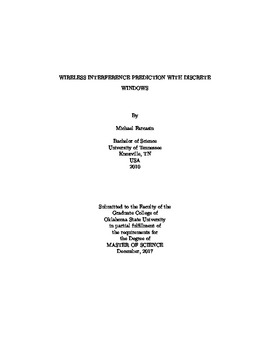| dc.contributor.advisor | Chan-Tin, Eric | |
| dc.contributor.author | Farcasin, Michael Ryan | |
| dc.date.accessioned | 2018-06-18T17:29:54Z | |
| dc.date.available | 2018-06-18T17:29:54Z | |
| dc.date.issued | 2017-12-01 | |
| dc.identifier.uri | https://hdl.handle.net/11244/300105 | |
| dc.description.abstract | Low-power devices that rely on ZigBee wireless signals, such as embedded health care devices, face the problem of being drowned out by higher-power signals like WiFi. When that happens, those devices must spend time and battery power retransmitting those signals. In order to reduce collisions with WiFi signals and increase throughput, we investigate using Hidden Markov Models (HMMs) with discrete timeslots to predict when interference would occur, and when it would not (a white space). We found that, when we used short timeslots, the HMMs made slower and less accurate predictions than existing schemes. However when we looked at longer timeslots, HMM predictions made better use of the available white space. | |
| dc.format | application/pdf | |
| dc.language | en_US | |
| dc.rights | Copyright is held by the author who has granted the Oklahoma State University Library the non-exclusive right to share this material in its institutional repository. Contact Digital Library Services at lib-dls@okstate.edu or 405-744-9161 for the permission policy on the use, reproduction or distribution of this material. | |
| dc.title | Wireless Interference Prediction with Discrete Windows | |
| dc.contributor.committeeMember | George, K. M. | |
| dc.contributor.committeeMember | Crick, Christopher | |
| osu.filename | Farcasin_okstate_0664M_15453.pdf | |
| osu.accesstype | Open Access | |
| dc.description.department | Computer Science | |
| dc.type.genre | Thesis | |
| dc.type.material | text | |
